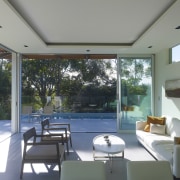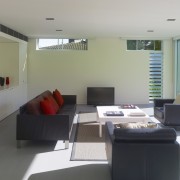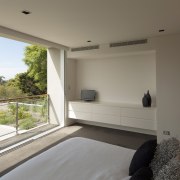With due respect new house in heritage suburb
New house by Joseph Alliker of RAAA
There is a strong appreciation of our heritage suburbs today, but this wasn't always the case. Back in the '50s, for example, local authorities allowed a red brick-and-tile pitched-roof house to be built right in the centre of Castlecrag, Sydney a heritage suburb designed in the 1920s by renowned Canberra city architect Walter Burley Griffin.
With the older properties having flat roofs and a sandstone construction, the '50s house was a serious incongruity, says Joseph Alliker of Rudolfsson Alliker Associates Architects, the architect responsible for the design of a new home to replace the red brick house on the site.
"The original homes sit on curved, radiating streets that appear carved out of the local rock. They are relatively small, mainly single-storey houses on large blocks given over to greenery, with gardens running into one another, and shared areas of parkland. The houses on either side of this one were the original display homes, and were considered quite radical for the time."
Not surprisingly, there were strict covenants in place for the new build, not only in terms of the aesthetics, but also in respect of retaining neighbour's views and privacy, and various setback requirements.
"It was logical to extend the house into the garden," says Alliker. "This determined the idea of the glass living pavilion, which pushes out to maximise the northern aspect. The bulk of the house remains in the same position as the original. We also decided to put the carport at the front, as another low, flat-roofed extension, which relates to the scale of the neighbouring properties. Walter Burley Griffin was adamant that all the houses in the development would have flat roofs."
Both of these single-storey extensions have planted green roofs, which minimise glare and light reflection and enhance the view from above and the street appeal.
The architect added timber sunshades to the garden pavilion to keep out the sun in summer. Large openings on three sides provide plenty of cross ventilation and maximise the leafy views, yet don't intrude on the neighbours' privacy.
"The house also has a huge thermal mass and low-e glass that keeps it cool in summer and warm in winter," says Alliker. "The planter box on the roof is a long, thick concrete beam. Yet the design still feels light on the interior the roof appears to float above high clerestory windows, for example."
A recessed tray ceiling in the living room, which features uplighting, helps to soften the living area and avoids an overwhelming flat plane. With the soffits around the edge lining up with the timber sunshades, the ceiling appears to extend outdoors. The floors are also flush with the terrace, with recessed door tracks top and bottom, to enhance the easy flow between inside and out.
Walls are painted in an off-white shade, providing a perfect backdrop for the owners' artworks. At one end of the living room, there is a contemporary, galley-style kitchen imported from Germany. This features white cabinetry and a wall of timber veneer.
A second living room, with a television, is positioned at right angles to the pavilion, within the two-storey volume. This room opens to a balcony facing east, but has small windows on the north side to avoid overlooking the neighbouring property. Here, as in every room, there is built-in furniture that provides streamlined storage for all the family's belongings.
"Maintaining an uncluttered look is a lot easier when there are places to store everything within easy reach," says Alliker.
The master suite is positioned directly above the second living room, where it has an attractive view across the green roof to the park-like surroundings of the neighbourhood.
Story by: Trendsideas
Home kitchen bathroom commercial design














